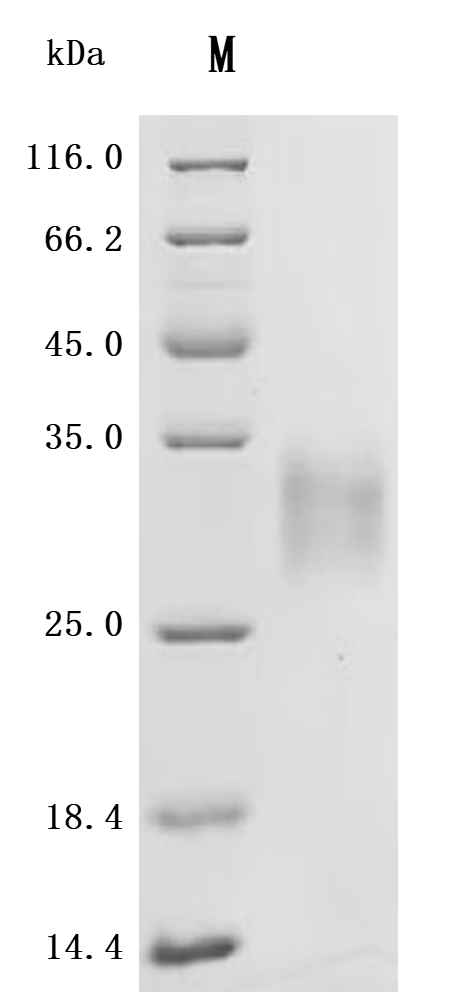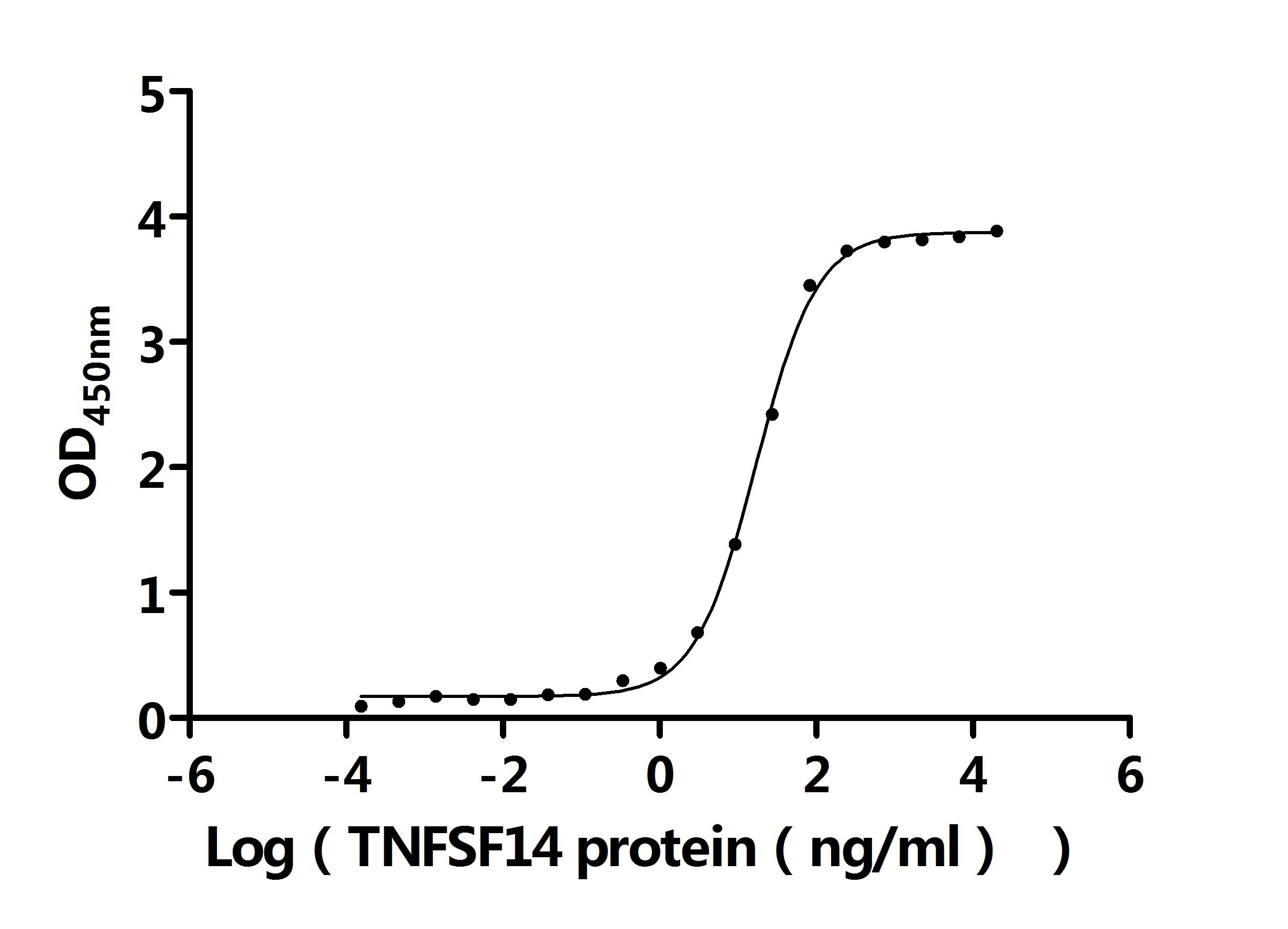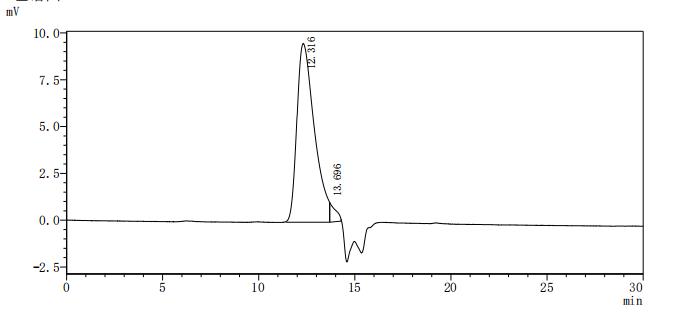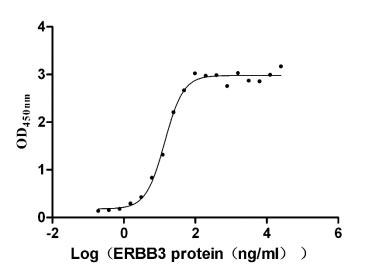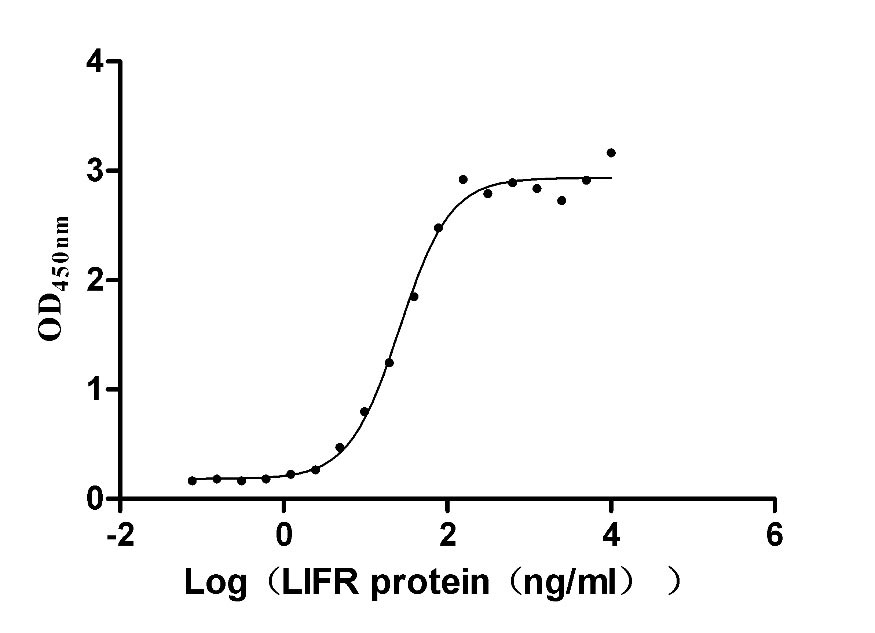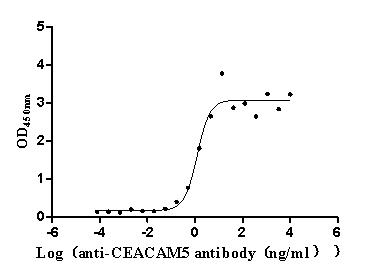Recombinant Mouse Tumor necrosis factor receptor superfamily member 3 (Ltbr), Partial (Active)
In Stock-
货号:CSB-MP013227MO
-
规格:¥1140
-
图片:
-
其他:
产品详情
-
纯度:Greater than 95% as determined by SDS-PAGE.
Greater than 95% as determined by SEC-HPLC. -
内毒素:Less than 1.0 EU/ug as determined by LAL method.
-
生物活性:Measured by its binding ability in a functional ELISA. Immobilized Mouse Ltbr at 2 μg/ml can bind human TNFSF14 (CSB-MP023991HUj7-B), the EC50 is 15.43-18.78 ng/ml.
-
基因名:
-
Uniprot No.:
-
别名:Lymphotoxin-beta receptor
-
种属:Mus musculus (Mouse)
-
蛋白长度:Partial
-
来源:Mammalian cell
-
分子量:23.1kDa
-
表达区域:31-223aa
-
氨基酸序列QLVPPYRIENQTCWDQDKEYYEPMHDVCCSRCPPGEFVFAVCSRSQDTVCKTCPHNSYNEHWNHLSTCQLCRPCDIVLGFEEVAPCTSDRKAECRCQPGMSCVYLDNECVHCEEERLVLCQPGTEAEVTDEIMDTDVNCVPCKPGHFQNTSSPRARCQPHTRCEIQGLVEAAPGTSYSDTICKNPPEPGAMLL
-
蛋白标签:C-terminal 10xHis-tagged
-
产品提供形式:Lyophilized powder
Note: We will preferentially ship the format that we have in stock, however, if you have any special requirement for the format, please remark your requirement when placing the order, we will prepare according to your demand. -
缓冲液:Lyophilized from a 0.2 μm filtered PBS, 6% Trehalose, pH 7.4
-
复溶:We recommend that this vial be briefly centrifuged prior to opening to bring the contents to the bottom. Please reconstitute protein in deionized sterile water to a concentration of 0.1-1.0 mg/mL.We recommend to add 5-50% of glycerol (final concentration) and aliquot for long-term storage at -20℃/-80℃. Our default final concentration of glycerol is 50%. Customers could use it as reference.
-
储存条件:Store at -20°C/-80°C upon receipt, aliquoting is necessary for mutiple use. Avoid repeated freeze-thaw cycles.
-
保质期:The shelf life is related to many factors, storage state, buffer ingredients, storage temperature and the stability of the protein itself.
Generally, the shelf life of liquid form is 6 months at -20°C/-80°C. The shelf life of lyophilized form is 12 months at -20°C/-80°C. -
货期:3-7 business days
-
注意事项:Repeated freezing and thawing is not recommended. Store working aliquots at 4℃ for up to one week.
-
Datasheet & COA:Please contact us to get it.
相关产品
靶点详情
-
功能:Receptor for the heterotrimeric lymphotoxin containing LTA and LTB, and for TNFS14/LIGHT. Promotes apoptosis via TRAF3 and TRAF5. May play a role in the development of lymphoid organs.
-
基因功能参考文献:
- These findings demonstrate the importance of LTbetaR signaling in leukocyte migration. PMID: 30069025
- our study clarifies the epithelial intrinsic role of LTbR on medullary thymic epithelial cells development and function; more importantly, it reveals a previously unrecognized function of LTbR on the control of the size of medullary thymic epithelial cells progenitor population. PMID: 28290551
- LTbetaR is required for T-cell regeneration on irradiation-induced thymic injury. PMID: 27493002
- Regulatory T-lymphocytes engage lymphotoxin beta receptor for afferent lymphatic transendothelial migration to preserve the survival of a pancreatic islet graft. PMID: 27323847
- Low LTBR expression is associated with Herpes Simplex. PMID: 29743364
- The LIGHT (Tumour necrosis factor ligand superfamily member 14, TNFSF14)/Lymphotoxin beta-Receptor(LTbeta-R) pathway, which is involved in T-cell and macrophage activation, was diminished in plasma and in apoE-/-Irs2+/-HL-/- atheromas. PMID: 27172975
- Data indicate that thymus medulla specialization for thymic tolerance segregates from medulla organogenesis and instead involves lymphotoxin beta receptor (LTbetaR)-mediated regulation of the thymic dendritic cells (DCs) pool. PMID: 28830910
- EAE induced by weak activation of innate immunity requires the NLRP3 inflammasome and is sensitive to interferon-beta treatment PMID: 27820602
- Data show that growth of regenerating splenic tissue is suppressed by lymphotoxin beta-receptor (LTbetaR) expression at non-splenic sites. PMID: 27936003
- LTbetaR is essential for efficient liver regeneration and cooperates with TNFRp55 in this process. Differences in survival kinetics strongly suggest distinct functions for these two cytokine receptors in liver regeneration. PMID: 26708145
- our results reveal a novel role for LTbetaR signaling in epithelial cells in the regulation of intestinal epithelial cell homeostasis to limit mucosal damage. PMID: 25183367
- expression on artery tertiary lymphoid organs protects against atherosclerosis in aged mice PMID: 26084025
- DC-derived LTBR ligands are critical mediators of lymph node cells survival, and LTBR signaling on reticular stromal cells is mediated by Pdpn expression. PMID: 25902483
- LTbR plays a role in macrophage-driven inflammation in atherosclerotic lesions from ApoE knockout mice, probably by augmenting the Ccl5-mediated recruitment of monocytes. PMID: 25740843
- M1 macrophages as inducer cells that trigger the expression of chemokines by vascular smooth muscle cell independently of lymphotoxin beta receptor signalling PMID: 24272771
- lymphotoxin beta receptor regulates the development of the CCL21-expressing subset rather than the Aire-expressing subset of postnatal Medullary thymic epithelial cells. PMID: 23585674
- found that conditionally LTbetaR-deficient animals failed to develop a significant proportion of their peripheral lymph nodes PMID: 23420877
- LTbetaR activation on mouse macrophages is involved in the control of pro-inflammatory cytokine and mediator expression by activation of a signalling pathway that controls exacerbating inflammatory cytokine production. PMID: 23220069
- LTbetaR activation on macrophages controls the pro-inflammatory response by activation of a TRIM30alpha-dependent signaling pathway PMID: 22437076
- LTbetaR activation on macrophages by T cell-derived lymphotoxin alpha(1)beta(2) controls proinflammatory responses by activation of a TRIM30alpha-controlled, counterregulatory signaling pathway to protect against exacerbating inflammatory reactions. PMID: 22357629
- Lymphotoxin-beta-receptor (LTbetaR) signaling, a pathway essential for lymphoid organogenesis, abrogates tertiary lymphoid organ development in heart transplantationl PMID: 21926237
- LTbetaR signaling in gut lymphoid follicles regulates IL-22 production by innate lymphoid cells in response to mucosal pathogen challenge. PMID: 21767811
- expression of tumor necrosis factor superfamily member 14 and lymphotoxin-beta receptor by motoneurons in vivo correlates with the preferential expression of interferon-gamma at disease onset and symptomatic stage in amyotrophic lateral sclerosis mice PMID: 21072055
- the LTbetaR signal exhibits a novel and unique function in promoting RANK activity for medullary thymic epithelial cell organization PMID: 21441458
- LTBR-pathway in Sjogren's syndrome: CXCL13 levels and B-cell-enriched ectopic lymphoid aggregates in NOD mouse lacrimal glands are dependent on LTBR. PMID: 21153342
- Following infection of LTbetaR(-/-) mice with the Gram-negative pathogen Citrobacter rodentium, IL-22 production from NCR22 cells was not affected. PMID: 21341264
- Lymphotoxin-beta receptor activation by lymphotoxin-alpha(1)beta(2) and LIGHT promotes tumor growth in an NFkappaB-dependent manner. PMID: 20473944
- show that a cognate interaction between LTalphabeta on CD4(+) helper T cells and LTbeta receptor on DCs results in unique signals that are necessary for optimal CD8(+) T-cell expansion via a type I IFN-dependent mechanism PMID: 21245292
- During ontogeny, only the LTbetaR pathway is crucial for development of the splenic marginal zone and the compartments of the white pulp (T, B, and mixed T/B cell zones). PMID: 21187446
- the LTbetaR modifies the ubiquitin:NIK E3 ligase, and also acts as an allosteric regulator of the ubiquitin:TRAF E3 ligase PMID: 20348096
- demonstrate that the LTbetaR signaling was required for the regulation of the early innate response against infection. PMID: 20226692
- Mouse aorta smooth muscle cells differentiate into lymphoid tissue organizer-like cells on combined tumor necrosis factor receptor-1/lymphotoxin beta-receptor NF-kappaB signaling. PMID: 20139367
- LT beta receptor and its interaction with LT alpha are required for the presence of B lymphocytes in the intestinal lamina propria. PMID: 11994450
- Embryonic LTbetaR is expressed from E16.5 onward in respiratory, salivary, bronchial and gastric epithelium, which may be consistent with early communication events between lymphoid elements and epithelial specialization in emerging mucosal lymph nodes. PMID: 11994460
- ligation of this receptor induces the processing of the cytosolic NF-kappaB2/p100 precursor to yield the mature p52 subunit, followed by translocation of p52 to the nucleus PMID: 12387745
- LTbetaR-induced activation of p100 processing is critically involved in the function of stromal cells during the generation of secondary lymphoid organ microarchitectures. PMID: 12556537
- comparison of signal pathways leading to NF-kB induction in response to TNFa and LTbR activation indicates LTbR-induced binding of RelB/p50 requires processing of p100 that is mediated by IKKalpha but is independent of IKKbeta, NEMO/IKKgamma, and RelA. PMID: 12709443
- Signaling of lymphotoxin (LT)alpha1beta2 heterotrimers via the LT beta receptor is an essential prerequisite for containment of intracellular pathogens Mycobacterium tuberculosis and Listeria monocytogenes. PMID: 12734369
- Immature isolated lymphoid follicles (ILFs) are inducible structures in the small intestine requiring LT beta-R for their formation. PMID: 12759424
- membrane lymphotoxin beta receptor is important in resistance to Theiler's virus infection PMID: 12882833
- Retention of mature T cells is associated with autoimmune phenomena, suggesting an unexpected role for LTbetaR signaling in central tolerance induction. PMID: 12953095
- role of activation in lymphoid organogenesis and tumor development PMID: 12957791
- Treatment with an LT beta receptor-Fc Ig fusion protein markedly inhibits the development of cutaneous graft-versus-host disease and weight loss, possibly by inhibiting the expression of adhesion molecules. PMID: 14734744
- In graft arterial disease, LTbetaR was expressed in smooth muscle cells (SMCs) with or without cytokine stimulation. The LIGHT pathway plays important roles in the regulation not only of T-cell activation but also of SMC proliferation. PMID: 15178556
- LTbetaR expressed on mast cells can transduce a costimulatory signal in T cell-dependent mast cell activation. PMID: 15187124
- Lymphotoxin-beta receptor interactions are critical for immunity against Citrobacter rodentium in mice. PMID: 15521015
- Pregnant NOD mice treated with LTbr immunoglobulin fusion protein protected offspring from diabetes. PMID: 15561941
- Lymphotoxin beta receptor- and lymphotoxin alpha-dependent interactions are required to initiate postnatal development of small intestinal lymphoid aggregates. PMID: 15585839
- double positive thymocytes regulate the differentiation of early thymocyte progenitors and gammadelta cells by a mechanism dependent on the transcription factor RORgt, and the lymphotoxin (LT) beta receptor (LTbetaR) PMID: 15591166
- isolated lymphoid follicles (ILF) formation in the large intestine is accelerated by blockage of LTbetaR and TNFR55 signals in utero, and ILF, like colonic patches, might play a role in the induction of IgA response in the large intestine PMID: 15778401
收起更多
-
亚细胞定位:Membrane; Single-pass type I membrane protein.
-
数据库链接:

